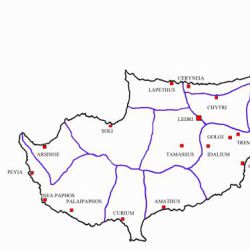Epitaphs and Tombstones of Hellenistic and Roman Cyprus
Introduction
Tombstones and their epitaphs yield excellent evidence on the nature of the population of Hellenistic and Roman Cyprus.1 Analysis of these monuments can reveal who the deceased were, their social classes, ethnic origins, and religious beliefs. The material provides commentary on the status of women and children, the relative prosperity of the island, and the degree of aggregation of the inhabitants to the culture of its rulers, be they Ptolemaic kings or Roman emperors.

Figure 1: Mitford's division of Cyprus into districts
Discussion of the tomb markers and related funerary sculpture proceeds by type, and is comprised of a description, discussion of its material, function, distribution through time and space, and the issue of local vs. foreign origin.2 The epitaph formulae are defined in Part III, and the questions addressed are similar to those discussed in Part II, with the added concerns as to who was commemorated, including issues of gender, age, class, ethnicity, profession, religious affiliation, and the identity of the mourners. Of particular interest is what these monuments reveal about the interactions of Cyprus with the rest of the eastern Mediterranean during the Hellenistic and Roman periods.
1 This article summarizes the findings presented in Chapter 3 of my PhD dissertation (Parks 1999). Dr. Eugene N. Lane was unstinting in his assistance, particularly with the handling of the epitaphs. In gratitude, I offer this article for his . Thanks are owed to F.J. Garrod and D. Barber for their assistance with the graphics.
2 Discussion of geographical distributions will rely upon Mitford’s analysis of the organization of Roman Cyprus (Mitford 1980). The Iron Age city-kingdoms each controlled a substantial hinterland, evolving into the Ptolemaic administrative organization, which subsequently was transformed into the Roman district system. While Mitford’s contention that Ledri was no longer extant by the Roman period is incorrect, the configuration of the coastal districts is sound (Parks 1999, Chapter 2). Mitford divided the interior of the island between Tamassus and Chytri Districts; allowance must be made for the territory of Ledri. For the purposes of this article, Mitford’s system will be followed, see Fig. 1.